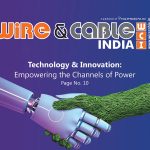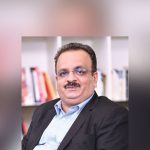Runaya Group is a fast-growing manufacturing start-up that leverages best-in-class technology and relationships with international partners to create innovative solutions in the resources sector.
Founded in 2017 with the vision to deploy cutting-edge technology in the manufacturing sector in India, the company aims to revolutionise the resources industry by creating innovative solutions. Runaya’s FRP plant is a state-of-the-art UV technology pultrusion plant that produces both coated (EAA) and uncoated FRP rods currently with fully automated lines and advanced quality control systems. In a conversation with Wire & Cable India magazine, Mr. Naivedya Agarwal, Co-Founder and CEO, Runaya Group, presents the new developments at the company, the demand for FRP rods, the expansion plans, and the market presence of Runaya Group.
Wire & Cable India: Could you please give us a brief overview of Runaya Group and the key accomplishments so far?
Naivedya Agarwal: Founded in 2017, Runaya has two main verticals – sustainability solutions and technology-driven niche manufacturing. Across both of these verticals, we work with technology providers, and joint venture partners – to create value for all our stakeholders.
On the ‘sustainability’ front, we have two operating businesses. In the aluminium rod processing business, we convert 2 percent of waste from primary aluminium manufacturers through our technology-driven processes. We have been looking forward to doing the same in the zinc value chain, where we recover all of the minor metals like lithium, cobalt, antimony, and so on from zinc waste.
Watch: Wire & Cable Industry Year Review
Within ‘technology-driven manufacturing’, we have two operating businesses. Firstly, within our joint venture with Minova International, an Australian company, we manufacture ground-support products for underground mining, infrastructure, and tunnelling projects, including – rock bolts, resin capsules, injection chemicals, wire mesh and high-quality ventilation systems. These products are aimed for applications in metro tunnels, railway tunnels, highways, etc. For instance, we are now supplying these bolts to tunnels that have been built for the Char Dham Yatra.
Additionally, we also manufacture Fibre Reinforced Plastic (FRP) Rods, which are considered the backbone of the telecom industry. These rods provide strength to the fibre optic cables enabling them to be deployed under tough conditions.
WCI: Kindly talk about the features of the FRP Rods and the manufacturing capabilities.
NA: Presently, in the FRP business, we have the capacity of one and a half million km of UV FRP. We are working to expand our production capacities to reach three and a half million km by the end of the next year.
Moreover, we are in the process of commissioning our Aramid-Reinforced Plastic (ARP) facility with a capacity of half a million km in the next two months. Our portfolio is largely driven by value-added products. Thus, we provide and build out our solutions including rough FRP rods, flat FRP rods, water-swellable FRP rods, steel embedded FRP rods, along with our ARP plant which we are currently commissioning.
WCI: Please elaborate more on the product development that the company has been undertaking.
NA: We, at Runaya Group, believe in constant innovation, and we have set up a dedicated innovation cell across our future power businesses. For FRP, we work directly with our customers to see what new products could be relevant for them. Some of the new products under development include medium FRP and oval FRP rods, amongst others.
We also use our innovation cell to improve our quality parameters and make sure that there is great customer retention. We are the first in the industry to actually deploy artificial intelligence-vision control systems, across our production lines, to ensure that the quality is monitored without any cumulative errors. And that there is no ambiguity regarding whether the product is fit for the customers or not because if the system has accepted, that means the customers will not have any complaints.
In line with our ESG focus, the cell also works on how we can minimise our scrap and waste. We believe that we are already at the benchmark level of 1-1.5 percent as per the industry benchmarks.
WCI: Since FRP rods are primarily for the telecom sector, and there’s been a notable surge in the telecom sector with the rise in demand for optical fibre cables with some national-level initiatives like Bharatnet; how do you see these trends propelling the growth of the company and of the optical fibre cable sector, as a whole?
NA: Since the demand for optical fibre cables is already there and the advent of COVID-19 further accelerated the demand for digitialisation with the rise in work-from-home culture, we believe that the demand for optical fibre cables, in the next five-seven years, will go up to about 650 million fibre km. Moreover, the rise in OTT platforms means that people have started consuming more and more data on different devices, including smartphones, laptops, etc. The current demand for FRP rods in the present year is around 10 million fkm, and we expect it to be doubled in the next four-five years. Thus, I believe that there will be no obstructions and impediments with regard to the growth factor.
WCI: What are the recent developments at Runaya Group in terms of – capacity augmentation and market expansion?
NA: As mentioned, specifically under the FRP business, we are planning to add up to half a million km to the current capacity of one and a half million km. In the non-cable business, we are also evaluating entering into other segments, including rare earth metals. And since again, ESG is at the core of what we do, it is very important for us to play a role in the localisation of the electric vehicle value chain. Considering the fact that rare earth metals play a critical role in that, we have now been working with the technology partners in China and Japan, to set up a new plant in the next year. In addition, we have also been in close partnership with a large Japan-based corporation, to manufacture gas atomized metallurgical powder in India, which will be used in a number of industries, including, automotive, Indian space and defence sectors, DRDO, etc.
Also Read: Runaya: Catering to the Domestic and Global Needs through State-of-the-art FRP Plant
WCI: What is the current market presence of the company?
NA: In FRP, we currently cover 18 percent of the domestic industry, and 20 percent is taken up by the export industry. Going forward, as we increase the capacity, we have a commitment to supply to our domestic customers, because, as a group, we always believe that India comes first for us. We will start looking at export markets when we expand our capacity.
WCI: What are the future plans of the company?
NA: In the future, we will increase our focus on the six businesses that we have, and once we expand our initial capabilities, we will look forward to continuing ramping up our presence in the industries, where we are already present. Additionally, we have also been looking forward to doubling up our top-line growth in the next few years.





